Introduction: Working with stones
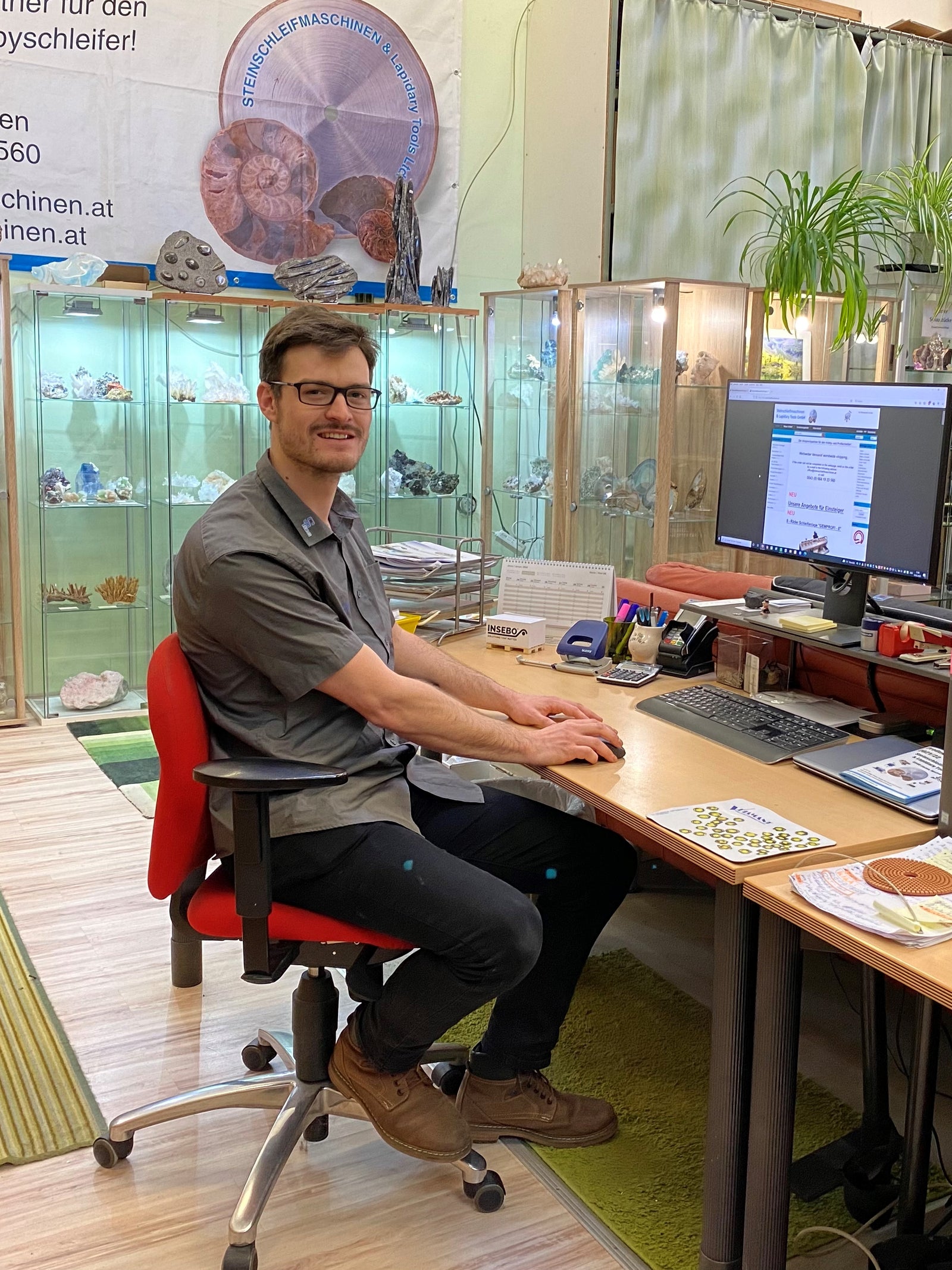
1. Introduction
1.1 History
The processing of stones, minerals and fossils has a long tradition. As early as the Stone Age, people made tools out of hard stones such as flint, jasper and the like. to e.g.b Knife blades, weapons, etc. in the simplest possible way by giving these stones the appropriate shape by hand for different purposes. Already in the Middle Ages, among other things,a Colored stones, semi-precious and precious stones are processed into jewelry and decorative items. The processing, i.e. grinding and polishing, of these stones was a complex process back then, as everything had to be done by hand in the beginning. Guilds emerged that specialized in stone processing. At that time, only real minerals, colored stones, semi-precious and precious stones were processed, as synthetic production was not possible. The polished stones used to be very important because they were used in jewelry, crowns, garment clasps, etc. were used and were not accessible and affordable to everyone. The grinding and polishing process, later powered by water power and sandstone wheels, was closely guarded by the grinders and was a strenuous and time-consuming process. Great exhibits such as thin-walled bowls, cups, cameos and much more. you can today anda Admire in the gemstone museum in Idar-Oberstein. These artists deserve the highest respect - considering the simple tools they used at the time.
1.2 Present
Today the situation looks a little different. Almost anyone can learn to work on stream stones, pebbles, minerals, precious and semi-precious stones, as well as fossils if they have the appropriate tools. Thanks to a wide range of machines for mineral and gemstone processing, this activity is now very widespread as a hobby as well as professional production and allows access to a large number of interested people. The information below results from our own practical information, i.e. from the practitioner for the practitioner and is not the result of scientific studies.
How do you process stones, minerals, semi-precious and precious stones, fossils these days?
This answer depends heavily on the purpose of the grinder as well as the size, condition, etc. of the stones. Some make a flat grinding or a slice of the stone with a flat grinding machine in order to “get out” the inner structures of the stone, others round the stones with a spirator or tumbler according to their natural shape, many grind pendants, cabochons, ring stones and various others Jewelry with wheel grinding machines, cabbing machines from them, some grinders refine the beautiful raw gemstone with many surfaces (facets) using a faceting machine, balls, sculptures and a wide variety of objects are also ground from the stones and much more.
Depending on the grinding goal, there are a variety of processing options that can be considered. A distinction is also made as to whether you grind stones by hand or use machines (machine grinding).
How are stones, minerals, gemstones, etc. sanded by hand?
There are a number of tools available for this. Here is an excerpt:
- Grinding on a glass or metal plate with loose abrasive grains with the addition of water (Sica, aluminum oxide, corundum,
- Sanding with a sanding block using wet sandpaper (Sica equals silicon carbide) with water
- Grinding with diamond hand pads with water
- Grinding on a diamond grinding plate (“lap”) with water
- Diamond-coated tools such asb Diamond file with or without water
In some countries, foot-operated treadle sanders are also used (similar to a foot-operated sewing machine...) with sometimes very nice results.
In many cases the stones are separated or polished before the grinding and polishing process. formatted (cut) to achieve targeted results. This often saves you a lot of grinding work. Cutting actually involves “grinding” the stones. Cutting loops. Diamond cutting saws with electroplated diamond saw blades or sintered cutting blades are usually used for this purpose. Various machines are used for this purpose.
Here is an excerpt:
- Table or stand saw with diamond cutting blade
- Cut saws with dia.-Separator sheet
- Angle hand grinder with stone cutting blade (disc) or diamond saw blade (FLEX) dry cutting
- Ring saws with diamond saw ring
- Band saws with diamond cutting band
- Slab saw for cutting stone slabs
- Trim saw for smaller cutting work, e.g.b Preparation of cabochons, pendants, etc. Stencils with predetermined shapes are often used, which are transferred to the stones with a brass or aluminum pen.
2. How are stones cut?
In most cases, they are held securely with both hands and guided through the rotating saw blade or cutting belt (for band saws). (In compliance with all relevant safety regulations!).
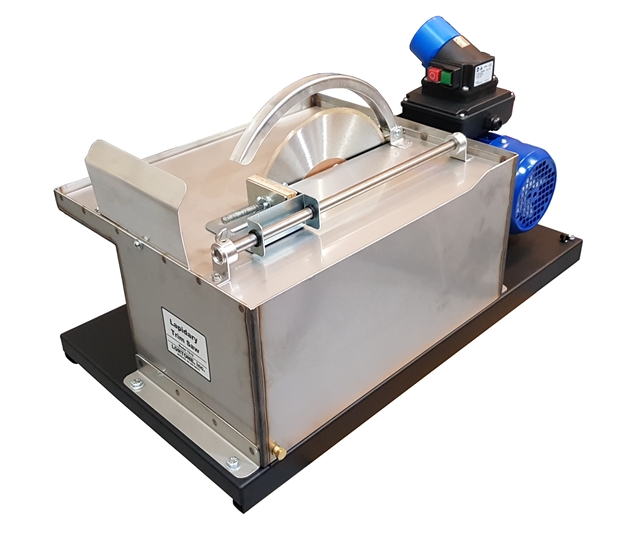
Stone cutting saw TS10 (table model) with stone clamp and manual feed
Or the stones are firmly clamped in a stone clamp and then guided through the saw blade manually or using a feed (weight or electric feed). (In compliance with all relevant safety regulations!).
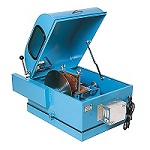
Stone cutting saw with electric feed (also known as an automatic saw)
Cooling oils and additives are used as cooling additives. Water alone is the worst choice as it does not provide enough cooling for the saw blade in the cutting area. Cutting additives that are mixed with water have proven to be a cheaper option. Very hard stones are usually separated with pure cooling oil. Please read the data sheet as it may... Substances that are harmful to health and the environment are included. Only cut with breathing/mouth protection!
The diamond saw blades should also be sharpened from time to time, as the diamonds on the saw blade become rounded and the saw blade no longer cuts properly. In order to make these angular again, variousSharpening materials/sharpening stones used. You should not leave saw blades in the cooling water additive mix for a longer period of time, as they can be attacked by rust and then lead to damage or even injuries during operation! Therefore, drain the coolant to such an extent that the saw blade is no longer immersed in it. Alternatively, a circulation pump system can also be used. The maximum speeds specified by the saw blade manufacturer must also be strictly adhered to. This must not be exceeded!
Conclusion: the nicer the cut, the less grinding work you have to expect. The cutting quality (roughness of the surface) depends on various factors:
- Saw blade
- Speed
- Feed speed (how fast is cutting)
- Coolant
3. Grinding stones
3.1 Machine sanding with sanding sheets (coated with silicon carbide. “Wet sandpaper”. Wet sanding
This involves using bonded, inexpensive abrasive which is applied to lightly cardboard sheets (also available in hardware stores). It is cut to disk format and applied (glued) to a flat carrier plate using a pressure-sensitive adhesive (spray). Worn sanding sheets can be removed and the carrier disc can be re-coated. The results are impressive as the quality of the sandpaper is consistently good. It should be noted that the coarse grains are operated at low speed (150-300 rpm) in order to become flat. The disadvantage of wet sandpaper is that these sanding sheets wear out relatively quickly and become dull, which leads to higher costs for harder stones. The grinding time is also longer compared to diamond grinding discs (“laps”). If you proceed carefully, this method will also produce clean results.
Polishing is carried out on various media such as:b Felt, cork, leather, plastic plates with diamond polishing pastes and polishing oxides. When polishing with cerium oxide and other oxides, speeds of 150-200 rpm are recommended while keeping the polishing wheel moist.
Dry sanding with water sandpaper is generally not recommended for health reasons!
3.2 Mechanical sanding on wet - belt sander
A method that is much more common in the USA and South America than in Europe. Sica or diamond grinding belts are used with the addition of water to cool and float the sanded material. This method is also used as dry grinding, which is, however, a health concern.
3.3 grindings with sintered diamond grinding discs, wet grinding
This method certainly has its advantages, especially for planning after editing, as it is quick. The service life of the sanding plate is long to very long depending on the height of the covering and can therefore also be described as economically efficient. It should be noted that the disc must be processed from time to time with a diamond dresser in order to remain as flat as possible. Many grinders avoid this method, especially when using multiple sintered discs, as it involves considerable costs. These sintered disks are found more frequently in the faceting machines.
3.4 loops with sanding drum, spirator (tumbler)
With such devices the original shape of the filled stones is changed slightly to significantly. This depends on the abrasive grain size and the grinding time. The cut and polished stones are called “baroque” cut. Not only raw stones but also pre-ground pendants, stone slabs and pre-cut stones can be ground and polished. The average Processing time is 2-4 weeks depending on the hardness of the stones. The stones are filled into the grinding container with the addition of loose abrasive grain (powder form) Sica or aluminum oxide, corundum, and water. The filling quantity should not exceed 2/3 in order to achieve proper mutual rubbing. With the spirator (tumbler), the grinding/polishing process is faster because these devices work at a high vibration speed and the stones grind each other more intensively in all directions. Many grinders add ceramic pellets or other material to which the abrasive grain binds during the grinding process. It is also important to add approx. 1/3 small “driver stones” (approx.1-2cm large pieces of marble or quartz chippings (depending on the hardness of the tumbled stones to be ground) which are responsible for the constant movement of the mass in the spirator. The mix of stones, abrasive powder, ceramic pellets and water filled in the spirator must constantly rotate slowly in circles and at the same time show a rolling movement. The amount of water filled is an important criterion, which determines whether everything spins well in the spirator or not. If you fill in too much water, the amount will soon congeal and vibrate at the stand, which will not be successful. So you start with a 2.5 liter spirator at the start of grinding with a 1/16 - 1/8 liter addition of water - in portions. Then you observe whether the mass rotates and rolls after a while. If necessary, always add a little water using a spray bottle. Monitor the process every few hours and add LITTLE water if necessary. After 24 hours everything should be cleaned and if more abrasion of the stone is desired, again with the same (but fresh) amount of abrasive powder (approx. 3 tbsp) grind. Then repeat the same process with the next finer grit, etc. If the tumbled stones are finally made with a grain size of 1200 (depending on the type of stone, etc.) have been finely ground, a thorough cleaning is required again, as polishing can now take place. Many grinders use their own polishing container for polishing so that no coarse grit from previous grinding passes can scratch the stones. Cleanliness and cleaning between the individual steps are the first priority here!
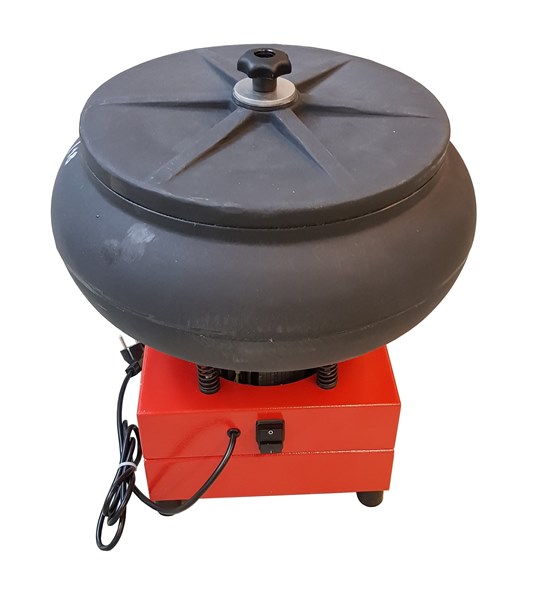
Polishing process:
The finely ground stones are filled into the polishing container with a suitable polishing agent, a little water and possibly the addition of polishing ceramic pellets. The small driver stones, which have now been finely ground, also go into the container so that the necessary rotation and vibration can begin. Some grinders also use polishing additives such as walnut shell pieces, small wooden cubes and much more (their secrets).
The finished, polished, baroque stones can then be set, provided with a pin eyelet or used loosely, etc.
Spirators are also used in various areas of industry for deburring, rounding and polishing.
In this context, the flat aspirator should also be mentioned, on which (only already cut) stones with loose grain are ground and polished under vibration. This process takes a lot of time, but it delivers nice results, especially if the support surface in the tub is made of hard metal (the common aluminum tubs, on the other hand, wear out after a while and a slight depression is created where the stones can no longer be found lie flat.) It is also helpful to put weight on the stones or stone slabs (putty or similar).) to weigh it down so that more contact pressure is created and the abrasion increases.
3.5 Machine grinding with loose abrasive grain (Sica=silicon carbide) on cast iron, metal disc
A long-established, still very good method for mineral processing. Cast iron discs are usually used for this, which have a slight slope (or not) towards the middle.
These discs are sometimes also grooved, which helps the removed grinding sludge to be separated better. Here we work at low speed (approx.100-180 rpm) to prevent the applied abrasive grain from being thrown off. A water/abrasive grain mixture is applied to the standing faceplate using a clean brush and distributed. You start with a coarse grit (K80-K120) with proper hand pressure and sand the stone flat with a circular motion. Then the face plate and the stone (and also the hands and fingers etc.) have to be removed.) must be cleaned carefully so that none of the coarse grain is carried along to the next, finer grain. After a few grain sizes you reach grain 600, 800 or even 1200. Then at a low speed (150-300 rpm) z.b with cerium oxide (e.g.a for the entire quartz group) polished wet on a felt polishing pad. Because of their wide range of applications, we recommend surface grinding machines with speed control, such as:b our EMSCH 200 RPM.
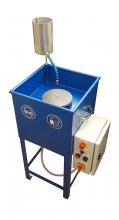
Plane grinding machine EMSCH 200 RPM
This method is often still used by agate grinders, who use it to achieve perfect results. Every agate grinder knows the procedure with the grinding time, increased contact pressure and the associated cleaning work.
We have replaced this process with our own developed special quartz/agate diamond grinding pads for ourselves and now also for many customers and achieve (almost) equivalent results after 3 grinding passes + polishing. Some sanders who use our own pads no longer polish because they lose the shine after the 3rd time. Pad is already enough. We therefore prefer these special pads because all of the disadvantages are eliminated.Grinding agates.
3.6 How does the machine grinding of cabochons work?
After a little practice and precise work, a popular form of gemstone cutting. For this purpose, translucent, interestingly structured, even less valuable stones, semi-precious stones such as:b various Types of quartz, cat tiger eye, cheap turquoise, lapis, agates, banded, patterned stones or simply the stones you collect yourself, but also valuable stones such as opals, star sapphire etc. Transparent, valuable types of stone without cloudiness, on the other hand, are usually faceted.Cabochons come in different shapes and thicknesses, and before cutting it is important to determine where the stone has the greatest shimmer, the best pattern, the best light refraction and the strongest color. To do this, you cut the stone into a disk and then draw the desired final shape on it. The shape can also be transferred from stencils using brass or aluminum pen. Then sawn in such a way that a little excess remains after the cut. This roughly cut stone is then ground out by hand (if not too small) according to its shape on the grinding wheel (usually a hard diamond grinding wheel with a hard grain of 80, 100, 120). The stone is then applied to a wooden dopp (stick) with stone putty or with 2K adhesive and sanded and finely ground with the finer grinding wheels. After grinding the wheel with grain 280 soft, dry the stone and check for any deep scratches and curvature defects, because such defects can now be corrected by regrinding with K 280. Usually you sand up to 1200 grit or better up to 3000 grit. (Speed approx. 1400-1700 rpm) the cabochon is finally polished and removed from the wooden dopp. The cemented stones are removed again using a flame and the 2K adhesive is removed with hot water. (approx.70-90 degrees) but you have to pay attention to which stones are sensitive to heat and you have to be careful with the flame. (Alcohol or gas burner). We also sell an electric putty melter.
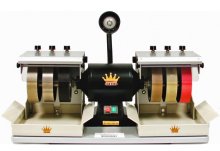
CabKing 6" for grinding cabochons
3.7 Machine grinding with diamond grinding pads
This innovative method has become increasingly popular over the last 10 years (still varies regionally).Slide pads are available in a variety of shapes and sizes. A loan has been taken here from the stonemasons who have been using it to work wet natural stone surfaces very successfully for a long time (FLEX). These pads are used in conjunction with wet hand angle grinders. Also in natural stone renovation (floors, window sills, kitchen worktops, etc.), these pads have been used for a long time. We took advantage of this for processing minerals and have been dealing with their shape, inner workings, bonding, diamond concentration and surface structure for over 6 years. Through years of research and testing, we are now able to produce special pads for minerals, gemstones, fossil processing, etc. to be able to offer that lead to very good results. All you need is water. We also use these pads on the surface grinding machines, e.g.b for grinding agates.
We offer these agate/quartz pads with Velcro for wet angle hand grinders (FLEX) as well as glued and pressed onto sheet metal discs, which can then be clicked onto surface grinding machines with magnetic disks. To be on the safe side, the magnetized mounting disc should have a centering pin so that the pads cannot be thrown off to the side at high speeds. Such plant plates can also be purchased from us.
The conventional diamond pads offered on the market (mostly of Chinese origin) are available in a wide variety of designs and designs depending on the various areas of application. These can only be used to a limited extent for mineral fossil processing, as they often have too little diamond grain, often no sieved diamond grain and a bond that is too hard, which inevitably leads to scratches.
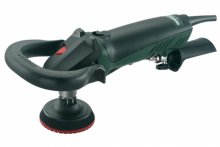
Wet angle grinder for diamond pads
3.8 carving technique
You can also often see “carved” stones that have been wet processed with a Dremel or other hand grinding devices. These tools are particularly popular when grinding opal, as they can be used, for example,b wavy, misshapen natural shapes where the opal layer sits on them can be sanded out without having to waste a lot of (expensive) opal paint. Hard, galvanized and sintered grinding wheels with pointed, round, concave shapes are often used here to get to the desired stone areas. Diamond grinding tips are also used here, such as those offered by Diamond Pacific as NOVA grinding points. Round-cut diamond abrasive films are also often used on soft surfaces.

Leave a comment